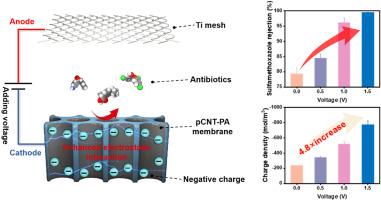Electric field responsive carbon nanotube-based polyamide membrane for enhanced antibiotics separation: from charge regulation to performance enhancement
IF 9
1区 工程技术
Q1 ENGINEERING, CHEMICAL
引用次数: 0
Abstract
Nanofiltration (NF) has significant potential for water reclamation, but it encounters several critical challenges, including unsatisfactory removals of dissolved small-molecular contaminants such as antibiotics, an inherent permeability-selectivity trade-off, and severe membrane fouling. Herein, we present a groundbreaking advancement in addressing these issues through an electric field-assisted filtration with a conductive NF membrane fabricated by interfacial polymerization of polyamide on a carbon nanotube substrate (pCNT-PA). The effects of electric field strength, solution pH, ionic strength, and combined organic-inorganic foulants on the removal efficiencies of various antibiotics of the conductive NF membrane under electric field-assisted filtration were investigated. The results show that, when the conductive membrane was used as a cathode under an applied voltage of 1.5 V, the rejection rates of sulfamethoxazole and ibuprofen substantially increased from 79.3 % and 59.3 % to 99.5 % and 90.8 %, respectively. This improvement is primarily attributed to the electric field induced increase in membrane charge density, rather than the alteration of membrane pore size. The elevated charge density enhances the electrostatic repulsion between anionic antibiotics and negatively polarized membrane. Based on this mechanism, the pCNT-PA membrane presented voltage-gated separation towards binary and ternary antibiotics with distinct charge characteristics. Furthermore, the electric field-assisted NF process exhibited remarkable antifouling performance, maintaining over 95 % sulfamethoxazole removal efficiency in the presence of combined organic-inorganic foulants. This work advances the understanding of electric field-regulated antibiotic removal mechanisms in NF systems, providing new theoretical insights for the development of intelligent responsive membrane separation technologies.

电场响应碳纳米管聚酰胺膜增强抗生素分离:从电荷调节到性能增强
纳滤(NF)在水回收方面具有巨大的潜力,但它遇到了几个关键的挑战,包括对溶解的小分子污染物(如抗生素)的去除效果不理想,固有的渗透性-选择性权衡,以及严重的膜污染。在此,我们提出了一项突破性的进展,通过电场辅助过滤,通过聚酰胺在碳纳米管衬底(pCNT-PA)上的界面聚合制备导电NF膜来解决这些问题。考察了电场强度、溶液pH、离子强度和有机无机复合污染物对电场辅助过滤下导电纳滤膜对各种抗生素去除效率的影响。结果表明,以导电膜为阴极,外加电压为1.5 V时,磺胺甲恶唑和布洛芬的去除率分别从79.3%和59.3%大幅提高到99.5%和90.8%。这种改善主要归因于电场诱导膜电荷密度的增加,而不是膜孔径的改变。电荷密度的升高增强了阴离子抗生素与负极化膜之间的静电斥力。基于这一机制,pCNT-PA膜对具有不同电荷特征的二元和三元抗生素具有电压门控分离作用。此外,电场辅助纳滤工艺具有显著的防污性能,在有机-无机复合污染物存在的情况下,其磺胺甲恶唑的去除率保持在95%以上。本研究促进了对NF系统中电场调控的抗生素去除机制的理解,为智能响应膜分离技术的发展提供了新的理论见解。
本文章由计算机程序翻译,如有差异,请以英文原文为准。
求助全文
约1分钟内获得全文
求助全文
来源期刊

Journal of Membrane Science
工程技术-高分子科学
CiteScore
17.10
自引率
17.90%
发文量
1031
审稿时长
2.5 months
期刊介绍:
The Journal of Membrane Science is a publication that focuses on membrane systems and is aimed at academic and industrial chemists, chemical engineers, materials scientists, and membranologists. It publishes original research and reviews on various aspects of membrane transport, membrane formation/structure, fouling, module/process design, and processes/applications. The journal primarily focuses on the structure, function, and performance of non-biological membranes but also includes papers that relate to biological membranes. The Journal of Membrane Science publishes Full Text Papers, State-of-the-Art Reviews, Letters to the Editor, and Perspectives.
 求助内容:
求助内容: 应助结果提醒方式:
应助结果提醒方式:


